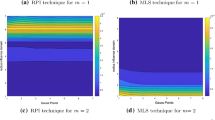A numerical scheme is developed for the assessment of the informational influence of election campaigns on the electorate. It relies on the determination of the probability density function of stochastic dynamic system states that requires a numerical solution of the Fokker–Planck–Kolmogorov equation reduced to a system of ordinary differential equations in the projection form of the Galerkin method. The approximation of the probability density function in state variables is specified on a triangulation in the system of Gaussian basis functions assuming time-dependent expansion coefficients. Convergence of the proposed numerical scheme is examined in the context of the convergence of the mean-square approximation of a function on a simplex. Some features of the algorithmic implementation of the solution are considered and comparative modeling results are reported for test problems.
Similar content being viewed by others
References
I. S. Polyanskii, K. O. Loginov, N. I. Il’in, and A. S. Velikikh, “Mathematical model of assessing the informational influence of election campaigns in social media on the electorate,” Matem. Modelirovanie, 34, No. 1 (2022).
A. P. Petrov, A. I. Maslov, and N. A. Tsaplin, “Modeling the choice of positions by individuals in an informational confrontation in a society,” Matem. Modelirovanie, 27, No. 12, 137–148 (2015).
A. P. Mikhailov, A. P. Petrov, G. B. Pronchev, and O. G. Proncheva, “Modeling the decline of social attention to a one-time past political event,” Doklady AN, 480, No. 4, 397–400 (2018); DOI: https://doi.org/10.7868/S0869565218160028.
A. P. Petrov and O. G. Proncheva, “Modeling the choice of positions by individuals in an informational confrontation with a two-item agenda,” Matem. Modelirovanie, 31, No. 7, 91–108 (2019).
A. P. Mikhailov, A. P. Petrov, and O. G. Proncheva, “A model of the propagation of information in a society,” Matem. Modelirovanie, 26, No. 3, 65–74 (2014).
A. S. Il’inskii, I. S. Polyanskii, and D. E. Stepanov, “Convergence of the barycentric method for inner Dirichlet and Neumann problems in ℝ2 for the Helmholtz equation,” Vestnik Udmurt. Univ., Math., Mechan., Computer Sci., 31, No. 1, 3–18 (2021).
I. S. Polyanskii, “Barycentric method in optimal control of the reflector surface shapre in a mirror antenna,” Matem. Modelirovanie, 29, No. 11, 140–150 (2017).
P. C. Kainen, V. Kurkova, and M. Sanguineti, “Estimates of approximation rates by Gaussian radial-basis functions,” CANNGA 2007, Adaptive and Natural Computing Algorithms, pp. 11–18; DOI: 10.1007/978-3-540-71629-7 2.
I. K. Daugavet, Theory of Approximate Methods. Linear Equations, 2nd edition, BKhV-Peterburg, St. Peterburg (2006).
N. N. Kalitkin, Numerical Methods [in Russian], Nauka, Moscow (1978).
I. S. Gradshtein and I. M. Ryzhik, Tables of Integrals, Sums, Series, and Products [in Russian], 4th edition, Fizmatlit, Moscow (1963).
G. E. Andrew and B. C. Berndt, Ramanujan’s Lost Notebook, Part V, Springer, New York (2013).
R. Strichartz, A Guide to Distribution Theory and Fourier Transforms, World Scientific (2003).
V. A. Emelichev, M. M. Kovalev, and M. K. Kravtsov, Polyhdera, Graphs, Optimization (Combinatoril Theory of Polyhedra) [in Russian], Nauka, Moscow (1981).
I. S. Polyanskii, D. E. Stepaov, D. K. Ketukh, and V. A. Shevchenko, “Electrodynamic analysis of mirror antennas in the barycentric approximation,” Fizika Volnovykh Protsessove i Radiotekhnicheskie Sistemy, 23, No. 4, 36–47 (2020).
T. H. Cormen, C. E. Leiserson, R. L. Rivest, and C. Stein, Introduction to Algorithms: Design and Analysis [Russian translation], Vilyams Publ. House, Moscow (2010).
I. S. Polyanskii, N. S. Arkhipov, and S. Yu. Misyuri, “Solution of the optimal control problem for an adaptive multibeam mirror antenat,” Avtomat. Telemekh., No. 1, 83–100 (2019).
J. R. Dormand and P. J. Prince, “A family of embedded Runbe–Kutta formulae,” J. Comp. Appl. Math., 6, No. 1, 19–16 (1980); DOI: https://doi.org/10.1016/0771-050X(80)90013-3.
Author information
Authors and Affiliations
Corresponding author
Additional information
Translated from Problemy Dinamicheskogo Upravleniya, Issue 68, 2021, pp. 15–28.
Rights and permissions
About this article
Cite this article
Il’inskii, A.S., Polyanskii, I.S., Loginov, K.O. et al. Numerical Assessment of the Informational Influence of Election Campaigns on the Electorate. Comput Math Model 32, 399–412 (2021). https://doi.org/10.1007/s10598-022-09542-5
Published:
Issue Date:
DOI: https://doi.org/10.1007/s10598-022-09542-5




